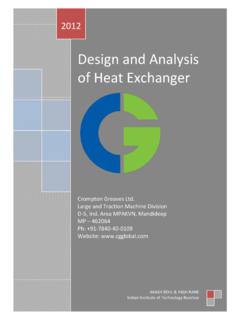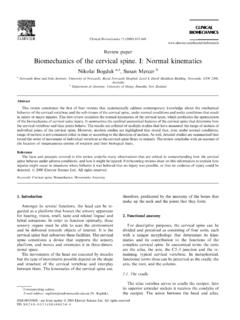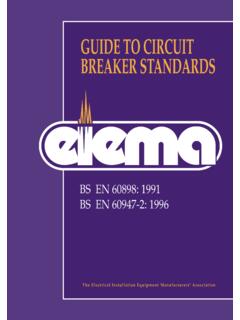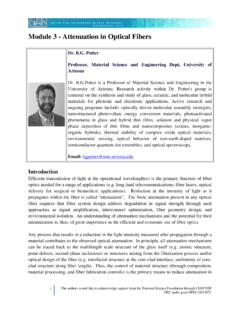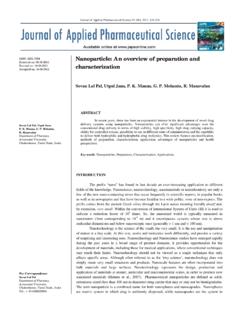Transcription of Properties of nanomaterials - 123seminarsonly.com
1 1 Properties of nanomaterials Introduction Nanoscience and nanotechnology include the areas of synthesis, characterization, exploration, and application of nanostructured and nanosize materials. The application of nanomaterials can be historically traced back to even before the generation of modern science and technology. Nanoparticles were used as dye materials in ceramics by ancient people [1]; Colloidal gold was used in medical treatment for cure of dipsomania, arthritis etc, as early as from 19 countries; Systemic experiments conduced on nanomaterials had also been started from the known Faraday experiments [2] in the 1857.
2 In 1959, Richard Feynman gave a lecture titled There's Plenty of Room at the Bottom , suggesting the possibility of manipulating things at atomic level [3]. This is generally considered to be the foreseeing of nanotechnology. However, the real burst of nanotechnology didn t come until the early 1990s. In the past decades, sophisticated instruments for characterization and manipulation such as scanning electron microscopy, transmission electron microscopy and scanning probe microscopy became more available for researchers to approach the nanoworld.
3 Device miniaturization in semiconductor industrial is also a significant factor for the development of nanotechnology. The Moore law stated that transistor performance and density double every 24 months as shown in Figure [4]. As the device dimension continues to shrink following this trend, there will be certain limitations due to both the intrinsic materials physics and the technological difficulties, which will remarkably raise the production costs.
4 For example, the quantum effects will become more apparent as the device dimension decrease [5]; The high dopant concentration needed for smaller devices will exceed the solid solubility limit, which will not form stable and uniform doping propile [6]; The high power density and the subsequent device overheating will cause serious problems in the scaling of devices; Lithographic technique for 2smaller critical dimension (CD) in the range of tens of nanometers for mass production posses technical difficulties[7].
5 To this point, nanotechnology may offer an alternative approach for continuing device scaling. Nanoelectronic devices based on new nanomaterials systems and new device structures will contribute to the development of next generation of microelectronics. For example, single electron transistor[8] [9] and field effect transistor [10-12] based on single wall carbon nanotubes are already on the way. Proto type simple logic circuits of carbon nanotubes have already been demonstrated [13-16].
6 Figure Moore law shows that the transistor performance and density double every 24 months. Further, nanotechnology was also expanded extensively to other fields of interest due to the novel Properties of nanomaterials discovered and to be discovered. For example, nanowires can be potentially used in nanophotonics, laser, nanoelectronics, solar cells, resonators and high sensitivity sensors. Nanoparticles can be potentially used in catalysts, functional coatings, nanoelectronics, energy storage, drug delivery and biomedicines.
7 Nanostructured thin films can be used in light emitting devices, displays and high efficiency photovoltaics. These are only a limited part of the fasting developing nanotechnology, yet numerous of other potential applications of nanomaterials have already been or will be discovered. During the real bursting of nanotechnology in the past decade, nanotechnology has become a real interdisciplinary research field in which many physicists, 3chemists, biologists, materials science and other specialists are involved.
8 Nanoinvestigations, being widely interdisciplinary by their very nature, promote the joining and merging of the various science and technology fields such as powder technology, colloid chemistry, surface chemistry and physics, clusters and aerosols, tribology, catalysis, simulation and modeling, computer technique, etc [17]. Typical nanomaterials [18] The term of nanomaterials covers various types of nanosturctured materials which posses at least one dimension in the nanometer range.
9 Table summerized the typical nanomaterials , which include zero dimension nanostructures such as metallic, semiconducting and ceramic nanoparticles; one dimension nanostructures such nanowires, nanotubes and nanorods; two dimension nanostructures such as thin films. Besides this individual nanostructures, ensembles of these nanostructures form high dimension arrays, assemblies, and superlattices. nanomaterials have the structural features in between of those of atoms and the bulk materials.
10 While most microstructured materials have similar Properties to the corresponding bulk materials, the Properties of materials with nanometer dimensions are significantly different from those of atoms and bulks materials. This is mainly due to the nanometer size of the materials which render them: (i) large fraction of surface atoms; (ii) high surface energy; (iii) spatial confinement; (iv) reduced imperfections, which do not exist in the corresponding bulk mateials [19]. Due to their small dimensions, nanomaterials have extremely large surface area to volume ratio, which makes a large fraction of atoms of the materials 4to be the surface or interfacial atoms, resulting in more surface dependent material Properties .






